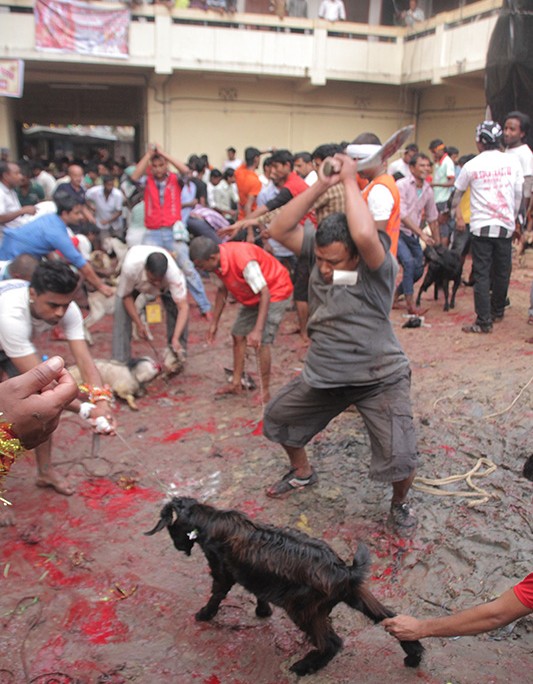ARM investigators recently infiltrated into Nepal, embedding themselves amongst one of the most anticipated festivals conducted in Nepal known most commonly as Dashain (traditionally known as Mwohni).
Reporting from the regions surrounding, Birgunj, and Janakpur, ARM documented three of the most significant animal sacrifice ceremony days of the fifteen-day festival. Hundreds of thousands of animals died to help humankind liberate themselves of their sins and grant them their wishes.
The ceremonies are in commemoration of the beliefs and traditions of bloody battles between the “divine” and “demonic” powers held within animals such as buffalo, goats, and pigeons. The idea is, sacrificing these animals will grant a variety of blessings that vary from fertility to blessing tradespeople safety from accidents and success.
Dashain is an annual celebration celebrated by Hindus and Buddhist Newars (with slight interpretations of the ceremonies) from around the globe and takes place in Nepal.
Hindu Newars especially worship the goddess Durga and her various manifestations throughout the Shaktipeeths of Kathmandu Valley.
Depending on the full moon of Shukla Paksha (bright lunar fortnight), the Dashain festival occurs in September or October. It is the longest and most anticipated festival in Nepal and even enforces the closure of all government offices, educational institutions, and many businesses in its honor. The most critical days are the first, seventh, eighth, ninth, and tenth days.
The eighth day, known as the ‘Maha Asthami,’ is the day when the most heightened of the Goddess Durga’s manifestations (known as the blood-thirsty Kali), is appeased through the sacrifice of hundreds of thousands of buffaloes, goats, pigeons and ducks in temples throughout the nation. In these ceremonies, blood is symbolic of its fertility and considered the most honorable offering to the Goddesses.
The sacrifices carrying on throughout the night of this day is called Kal Ratri (Black Night). It is typical for the sacrifice of buffalo to take place in the courtyards of all the land revenue offices in the country on this day. In Nepal’s old palace in Basantapur Hanuman Dhoka, worships and sacrifices are also active throughout this day and night in almost every courtyard.
On the midnight of the very day, the Dasain Ghar, 54 buffaloes, and 54 goats perish in observance of the rites. After the offering of the blood, the flesh of the sacrificed animals is prepared and eaten by the worshippers, believing that it is a blessing of divinity.
The ninth day is called Mahanavami, otherwise referred to as “the great ninth day.” Upon this day, the animal sacrifice ceremonies and rituals are at the highest concentration and of the highest regard where even official military officers participate on holy and royal grounds. Often, the people sacrifice buffalos buffaloes under the order of gun salute. Rituals take place at sacred locations such as the Taleju Temple, where on this day, the only day that the public may enter is one of the most densely populated visit sites.
The Animal Recovery Mission documented Dashain as a part of its efforts to install awareness and education amongst the people of Nepal, the government, and the rest of the world. The goal is to help implement animal protection laws within the country, as well as alternative offerings to the gods and traditions in Nepalese culture that do not result in the mass bloodshed slaughters that have been occurring for centuries.
Please continue to visit this page to learn more about this sacrificial festival. Click on the links to read about the festival from The Himalayan newspaper in Nepal here. For the international report in Nepalese Read here.
Please click on the button to sign and share ARM’s petition on Change.org to “STOP the mass animal sacrifice and slaughter during Nepal’s annual Dashain Festival.”
Dashain Festival: Day 7 & 8, The most prominent animal scarce days of Dashain.
 ARM’s Nepal undercover investigators have been in the field since October 13th, 2015, documenting different celebration styles and sacrificing around the plains of Nepal. The three Temples that they embedded themselves in to document animal sacrifice ceremonies included;
ARM’s Nepal undercover investigators have been in the field since October 13th, 2015, documenting different celebration styles and sacrificing around the plains of Nepal. The three Temples that they embedded themselves in to document animal sacrifice ceremonies included;
We hired two additional camera persons and rented two extra cameras to cover the events in Birgunj and Mahottari as the places were far apart and the events were to be conducted almost at the same time. It was worth it.You wouldn’t believe the kind of pictures and videos we have. It was rather disturbing around Sonmaisthan in Mahottari. There, people were fighting and competing for the slaughtered animals and whoever was powerful enough to drag the animals out, claimed them. People were beating one another and even the police were charging with sticks to get a control but it was not much help.And later when me and the other undercover investigator were done at Birgunj, we joined undercover investigator #3 around Mahottari, and headed to Janakpur for the night event.Janakpur proved to be the toughest as they threatened us multiple times to put the cameras away. The slaughtering area was totally inaccessible in Janakpur but we managed to take some pictures and videos here as people were rushing back to their homes with their slaughtered goats.Around 14,000 goats are estimated to be slaughtered in Rajdevi temple, Janakpur alone and it is ongoing now as I write to you. We are trying to attach some pics. If they don’t get delivered, we’ll send you some after reaching Kathmandu by tomorrow evening.
